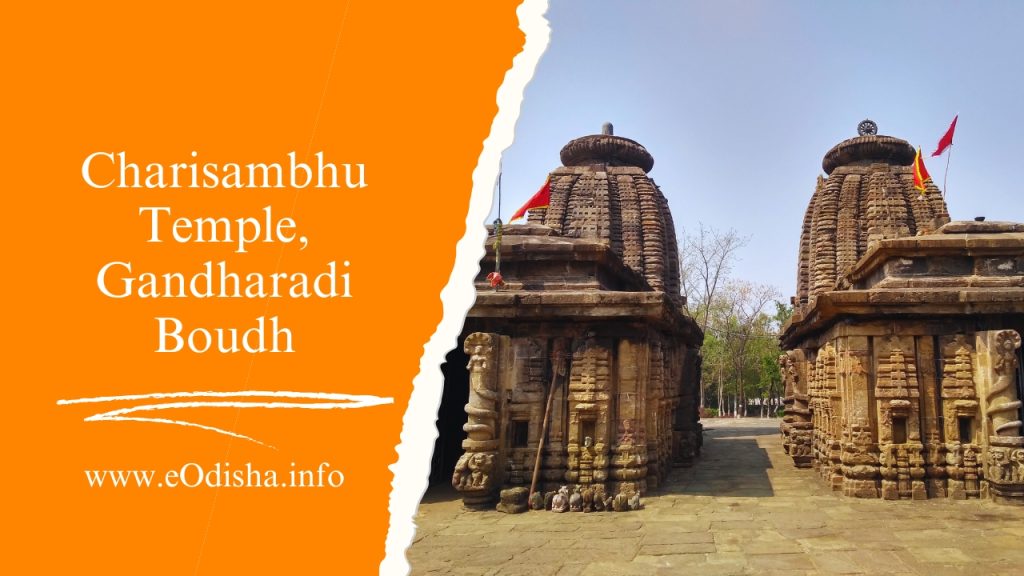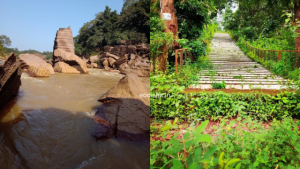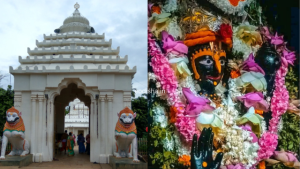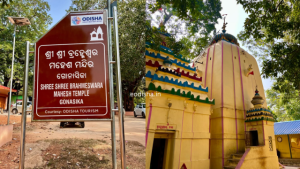Charisambhu Temple, located in Gandharadi, Boudh, Odisha, is a gem of ancient architecture. This temple complex is renowned for its stunning twin temples, showcasing the Kalinga style. The serene ambiance and intricate carvings make it a visual delight.
Gandharadi village, where the temple stands, is picturesque with lush greenery. The temple is dedicated to Lord Shiva and attracts devotees and tourists alike. Its calm and tranquil surroundings provide a perfect escape from the hustle and bustle.
The temple complex is well-maintained, reflecting the glory of its past. The peaceful atmosphere and the beautiful backdrop of nature add to the temple’s charm.
Contents
History of Charisambhu Temple
Charisambhu Temple dates back to the 8th century. The architecture reflects the Kalinga style, prominent in Odisha’s ancient temples. The temple has two main structures, often referred to as the twin temples. These are dedicated to Lord Shiva.
The temples have stood the test of time, witnessing numerous historical events. The exquisite carvings depict stories from Hindu mythology. These carvings showcase the artistic brilliance of the craftsmen of that era.
The temple has undergone several renovations. However, it still retains its original charm. The history of Charisambhu Temple is closely tied with the cultural heritage of Odisha. The temple’s architecture is a testament to the skilled craftsmanship of ancient times.
Visitors can see inscriptions that offer glimpses into the past. These inscriptions are valuable for historians and archaeologists. They provide insights into the temple’s origins and the era it was built in.
Best Things to Do
- Explore the Twin Temples: Marvel at the intricate carvings and the grandeur of the twin structures.
- Photography: Capture the beauty of the temple and the surrounding landscape.
- Meditation: Enjoy a peaceful meditation session in the serene temple grounds.
- Local Cuisine: Taste local dishes from nearby eateries.
- Nature Walks: Stroll through the lush greenery around the temple.
- Cultural Tours: Learn about the local culture and history from guides.
Why Visit
Charisambhu Temple, Gandharadi, Boudh, is a must-visit for history buffs. The ancient architecture and detailed carvings are mesmerizing. It’s also a spiritual haven for devotees of Lord Shiva.
Nature lovers will enjoy the scenic beauty surrounding the temple. The peaceful environment is perfect for a day of relaxation and reflection.
Photographers will find endless opportunities to capture stunning shots. The temple, with its rich history and beautiful setting, makes for a perfect picture.
Visiting the Charisambhu Temple offers a unique blend of history, spirituality, and nature. It’s a great spot to unwind and connect with the past.
How to Reach Charisambhu Temple
By Bus
Regular buses run from major cities in Odisha to Boudh. From Boudh, local transport is available to Gandharadi.
By Train
The nearest railway station is at Rairakhol, about 35 km away. From there, hire a taxi or take local transport to reach the temple.
By Flight
The nearest airport is in Bhubaneswar, around 200 km away. From the airport, hire a taxi or take a bus to Boudh, then proceed to Gandharadi.
By Personal Car/Bike
Drive down from major cities like Bhubaneswar or Cuttack. The roads are in good condition and the drive is scenic.
Where to Stay
- Hotel Nirupama, Boudh: Comfortable stay with modern amenities.
- OTDC Panthasala, Boudh: Government-run with decent facilities.
- Sambalpuri Sadan, Boudh: Traditional stay with local touch.
- Hotel Panchawati, Boudh: Budget-friendly with basic amenities.
- Forest Rest House, Boudh: Ideal for nature lovers.
Nearby Places to Visit
- Jagannath Temple, Boudh: Another beautiful temple in the region.
- Rameswar Temple, Boudh: Historic temple dedicated to Lord Shiva.
- Debrigarh Wildlife Sanctuary: Perfect for wildlife enthusiasts.
- Satkosia Gorge: Stunning natural beauty along the Mahanadi river.
- Boudh Town: Explore local markets and culture.
- Harishankar Temple: Scenic spot with a waterfall nearby.
- Chari Sambhu Beach: A peaceful spot to relax by the water.
- Bhairabi Temple, Manamunda: Another significant temple close by.
Conclusion
Charisambhu Temple, Gandharadi, Boudh, is a place where history and spirituality merge beautifully. The ancient twin temples are a testament to Odisha’s rich cultural heritage. The serene surroundings make it a perfect getaway for peace and relaxation.
Whether you’re a history enthusiast, a nature lover, or a spiritual seeker, this temple has something for everyone. The local culture, combined with the temple’s historical significance, offers a unique experience.
Visit Charisambhu Temple to step back in time and enjoy the tranquility of nature. It’s a journey worth taking, offering a blend of history, spirituality, and scenic beauty.
Is there any entry fee to visit Charisambhu Temple?
No, there is no entry fee to visit Charisambhu Temple. It is open to all devotees and visitors seeking blessings and spiritual solace.
Can photography be done inside the temple premises?
Photography is allowed inside the temple, but it is advisable to seek permission from the temple authorities before capturing photographs or videos.
Are there any nearby attractions to explore in Boudh district?
Yes, Boudh district has several other attractions worth exploring, including the famous Boudh District Museum, Ramanath Temple, and Jogindra Villa. These sites offer glimpses into the rich history and culture of the region.
Are there any specific dress code requirements for visiting Charisambhu Temple?
While there is no strict dress code, it is recommended to dress modestly and respectfully when visiting the temple out of reverence for the religious sentiments associated with the site.
Can I offer puja and prasad at Charisambhu Temple?
Yes, devotees can offer puja and prasad at Charisambhu Temple. It is customary to seek guidance from the temple priests for the proper procedures and rituals to follow during the offerings.




